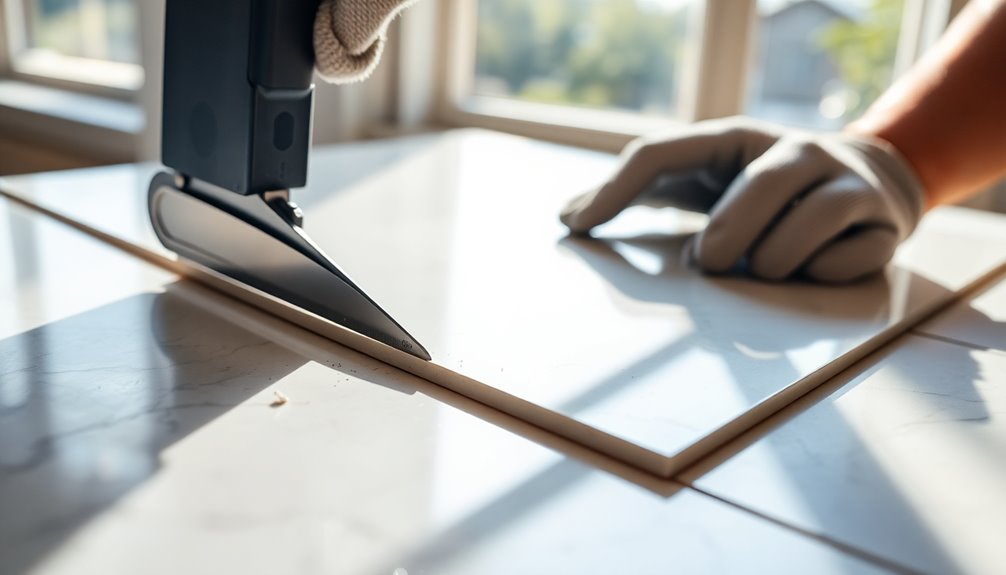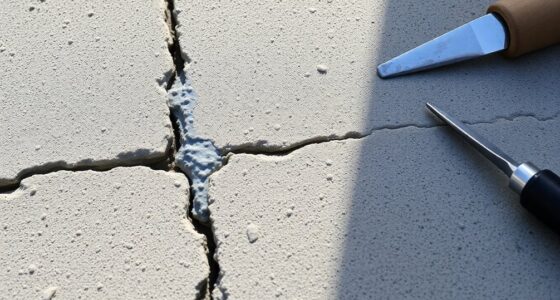To cut porcelain tile effectively, start with the right tools—a high-quality wet saw with a diamond blade is ideal for clean, precise cuts. Score the tile using a grease pencil, and apply firm, even pressure to minimize chipping. If you're using manual cutters, get a rubber mallet to help with thicker tiles. For small shapes, tile nippers or an angle grinder can be useful, but always practice on scrap tiles first. Maintain your tools for the best performance. By following these tips, you'll achieve a professional finish, and there's more to explore about enhancing your tile cutting skills.
Key Takeaways
- Use a high-quality wet saw with a diamond blade specifically designed for porcelain to ensure clean, precise cuts and minimize dust.
- Score the tile firmly and evenly with a manual cutter before applying pressure to break it along the line, reducing risk of chipping.
- Mark cutting lines with a grease pencil and use masking tape to protect edges from chipping during the cutting process.
- Practice on scrap tiles to refine techniques and gain confidence in your cutting skills before working on actual project tiles.
- Regularly inspect and maintain cutting tools, ensuring blades are clean and sharp for optimal performance and quality cuts.
Understanding Porcelain Tile
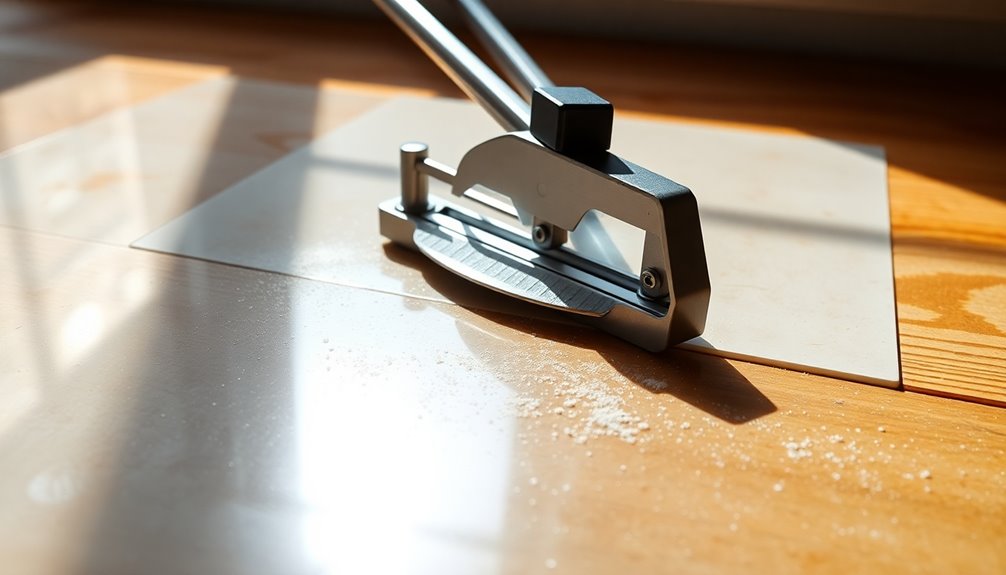
When it comes to flooring options, understanding porcelain tile is essential for making the right choice. Porcelain is incredibly durable, perfect for high-traffic areas and resistant to water splashes, making it ideal for kitchens and bathrooms.
You'll find three main types of porcelain tiles: through-bodied, which hides scrapes; glazed, offering a hard finish in various colors; and color-body, with a consistent hue throughout. The high-temperature firing process creates a denser, less porous material that resists stains and enhances strength.
Plus, porcelain tiles come in multiple finishes—matte, gloss, and textured—allowing you to match your aesthetic preferences. With simple cleaning using just water and a damp mop, maintenance is a breeze, making porcelain an excellent choice for your project.
Essential Cutting Tools
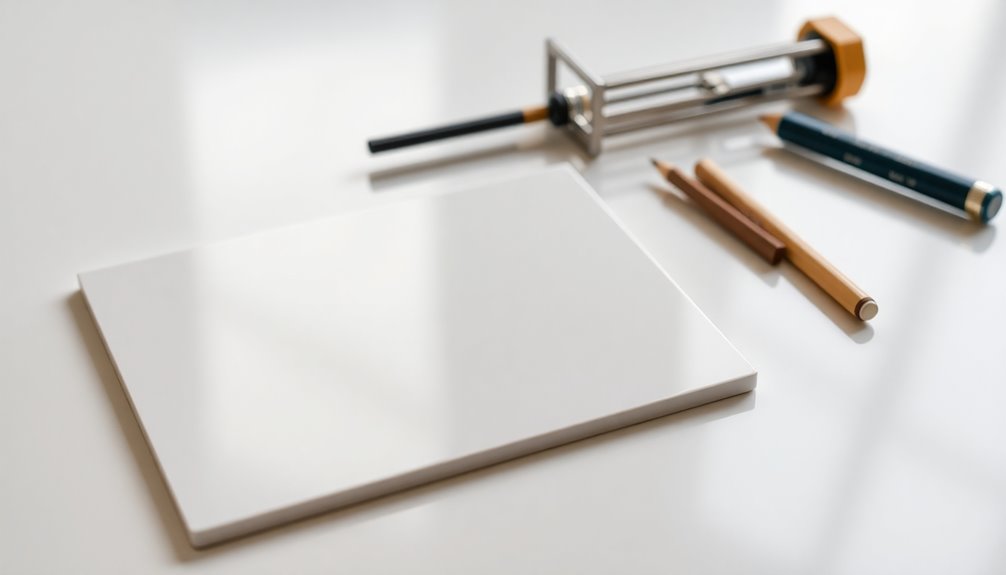
When you're ready to cut porcelain tile, having the right tools makes all the difference.
A manual tile cutter can be a budget-friendly option, while a wet saw offers clean, professional cuts for bigger projects.
Don't forget about diamond blades, which are essential for ensuring precision with electric tools.
Manual Tile Cutters
Manual tile cutters are indispensable for anyone tackling tile projects, whether you're a DIY enthusiast or a professional.
Designed for efficiently cutting various tiles, including porcelain, these tools are essential for achieving clean results. Prices range from $50 to $900, so you can find a model that fits your budget.
While more affordable manual tile cutters may struggle with thicker porcelain tiles, using a rubber mallet can improve your cutting results.
Keep in mind that although manual tile cutters can produce rough edges, they're ideal for most tile tasks.
For high-quality installations, consider a wet saw for a smoother finish, especially if you're working with natural stones like granite or marble, which manual tile cutters can't handle.
Wet Saw Benefits
Wet saws offer a range of benefits that make them an essential tool for cutting porcelain tiles. By utilizing water to cool the diamond blade during the cutting process, wet saws minimize dust and reduce the risk of overheating, resulting in cleaner, more precise cuts.
They excel at handling thicker tiles, which manual cutters often struggle with, ensuring consistent, straight edges. Many wet saws feature adjustable cutting angles, letting you make exact miter cuts for corners or intricate designs.
Additionally, using a wet saw considerably lowers the chances of chipping and cracking tiles compared to dry cutting methods, giving you a polished finish. Renting one for around $200 per week is a cost-effective choice for any DIY project involving large quantities of tiles.
Diamond Blade Options
Choosing the right diamond blade is essential for achieving clean cuts on porcelain tiles. Diamond blades are specifically designed to handle the hardness of porcelain, ensuring precision.
For best results, consider using wet cutting diamond blades; they reduce heat and dust with water, enhancing efficiency and extending blade life. If you're looking for speed, turbo diamond blades cut faster and are perfect for harder porcelain.
On the other hand, segmented diamond blades feature spaces between segments that aid in cooling and debris removal, making them ideal for tough materials.
Remember to match the diamond blade's grit size to your tile's hardness—smaller diamonds are better for harder tiles, while larger diamonds work well on softer ones. Additionally, using energy monitoring features can help you track the power consumption of your cutting tools, ensuring efficient usage.
Techniques for Tile Cutting
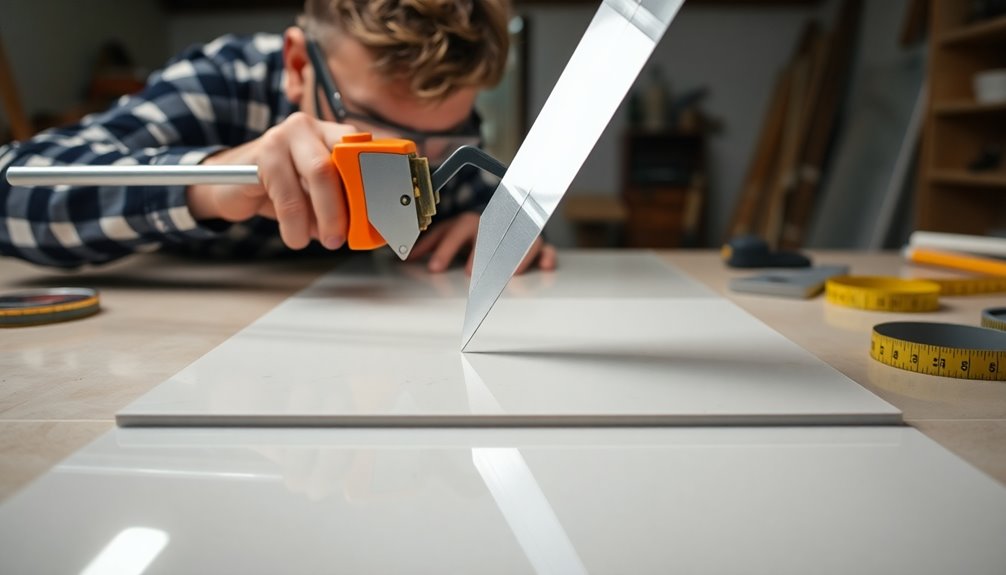
When you're ready to cut porcelain tile, start by marking your cutting line with a grease pencil and notching it to guide your blade.
This preparation makes a big difference in achieving straight and precise cuts.
Now, let's explore the best cutting techniques to guarantee you get clean edges every time.
Marking and Preparing Cuts
To achieve precise cuts on porcelain tile, it's essential to start with careful marking and preparation. Use a grease pencil to clearly mark your cutting lines; this guarantees visibility during the cutting process.
Create small notches along the marked line using a utility knife to guide the blade and improve accuracy. Apply masking tape along the edges of the cutting line to minimize chipping and achieve a cleaner edge afterward.
When setting up your manual cutter, use a rotating square and lateral stop to make straight cuts without needing additional markings.
Finally, verify your diamond blade is clean and sharp, as this greatly impacts the quality and precision of your finished edges.
Happy cutting!
Cutting Techniques Overview
Understanding the various cutting techniques can greatly enhance your tile project, allowing you to achieve cleaner and more precise results.
Start by marking your cutting lines with a grease pencil, and add notches to guide your blade. If you're using a wet saw, verify the water reservoir is full to minimize dust and heat; let the diamond blade do the work without forcing it.
Incorporate a leveler for larger or complex tiles to verify accuracy. Move slowly during the cutting process, checking for clean edges after each cut.
Additionally, applying masking tape along the edges can reduce chipping, especially on delicate tiles. This simple step not only ensures a cleaner finish but also saves time on touch-ups. Along with protecting your surfaces, it’s essential to know the best techniques for filling nail holes to maintain a seamless look in your interior. Using a lightweight spackle and smoothing it out with a putty knife can create an invisible repair that blends perfectly with the surrounding area.
Master these cutting techniques, and you'll successfully cut tile like a pro!
Using Tile Nippers
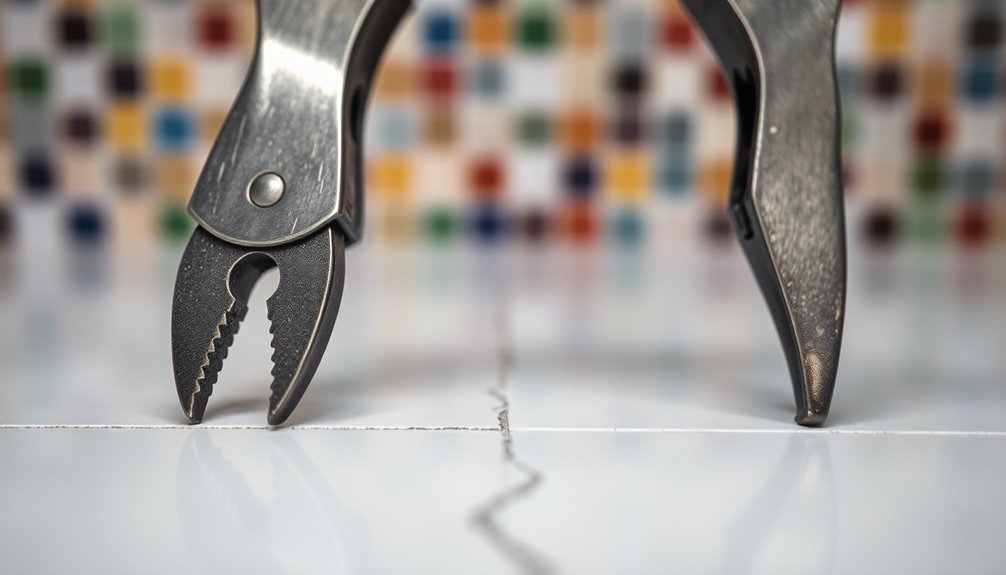
Although cutting porcelain tile can be challenging, using tile nippers makes it manageable, especially for intricate shapes.
Here's how to get the best results:
- Score First: Use a tile cutter to score the tile, creating a clean line for the nippers to follow.
- Apply Pressure: When using tile nippers, apply firm but steady pressure to avoid cracking the tile and guarantee a clean break.
- Practice: Before tackling your project, practice on inexpensive tiles to gain confidence with the tile nippers.
Recommended brands like Kobalt and QEP offer durable options designed for precision.
With the right technique, you'll achieve clean cuts on your porcelain tiles, making your tiling project a success!
Cutting With an Angle Grinder
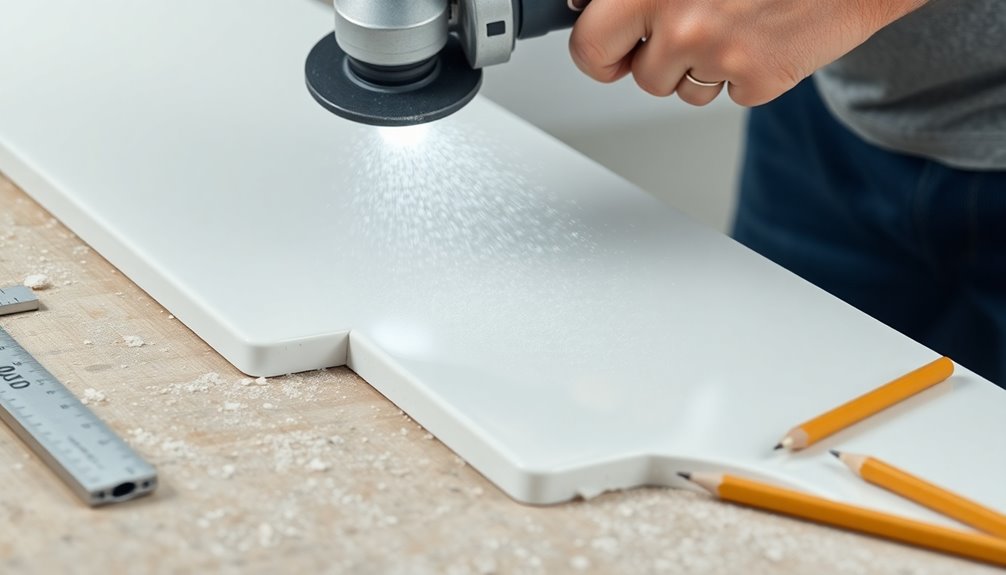
Cutting porcelain tile with an angle grinder is a fast and efficient method that can handle various cuts, from straight lines to intricate shapes.
To achieve the best results, use a diamond blade designed for porcelain, such as the DEWALT DW4765. This guarantees cleaner cuts and prolongs the blade's life.
When using the angle grinder, maintain a steady pace without forcing the tool; this allows the blade to guide the cut and minimizes the risk of chipping the tile.
With high RPM, always wear safety gear like goggles and a dust mask to protect yourself from debris and dust.
Angle grinders are cost-effective, with decent models available for around $30, making them perfect for DIY enthusiasts tackling tile cutting projects.
Advantages of a Tile Cutter
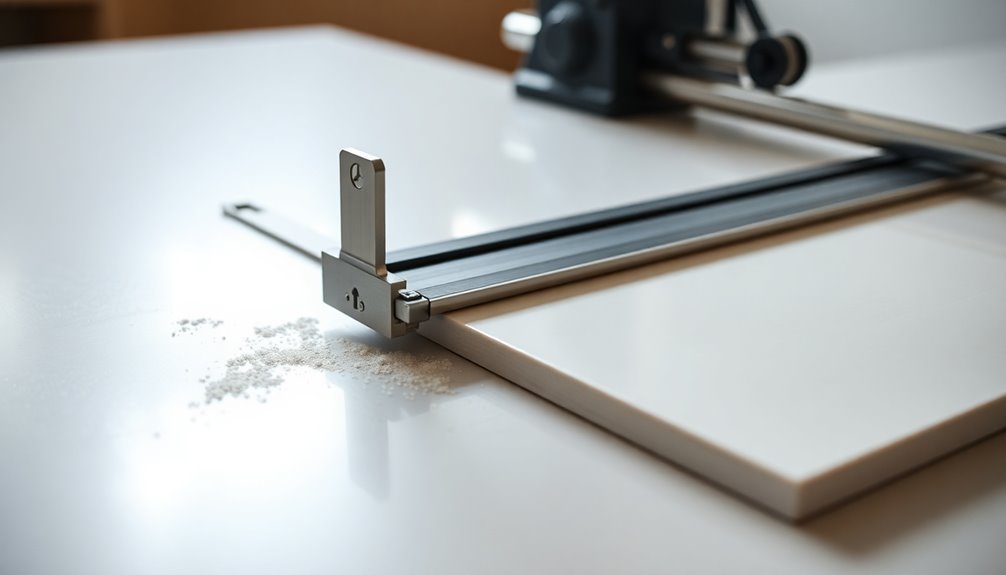
Using a tile cutter can really speed up your project while ensuring precise cuts every time.
Unlike other tools, it minimizes chipping, giving you clean edges that look professional.
If you're tackling a porcelain tile job, investing in a tile cutter is a smart choice.
Speed of Cutting
When you opt for a tile cutter, you'll discover that it considerably speeds up your project time, allowing you to achieve clean cuts in just 30 to 60 seconds. This efficiency can make a significant difference in your workflow.
Here are some key advantages:
- Quick Cuts: You can cut standard-sized porcelain tiles up to 17 inches in a single pass.
- Less Cleanup: Tile cutters generate minimal dust, promoting a cleaner workspace.
- Durability: High-quality options, like the Rubi TR 600, offer consistent performance over time.
With practice, you'll find that your cutting speed and accuracy improve, letting you complete large tile installations much faster than with a traditional saw.
Precision in Cuts
Achieving precision in cuts is essential for any tile installation, and a tile cutter excels in this area. With its scoring technique, a tile cutter allows you to create clean, precise cuts in porcelain tiles by scoring the surface and breaking along the line. This minimizes chipping and damage, ensuring a professional finish.
High-quality manual tile cutters, like the Rubi TR 600, can handle tiles up to 17 x 17 inches, providing consistent results across various sizes. By using a tile cutter, you streamline the cutting process, reducing the need for additional tools and enhancing efficiency.
As you practice, your proficiency improves, resulting in higher quality cuts and less material waste during your tile installation.
Tips for Clean Cuts

To guarantee clean cuts on porcelain tile, it's essential to use the right tools and techniques. Follow these tips for the best results:
- Use a high-quality wet saw with a diamond blade specifically for porcelain. This minimizes dust and heat, ensuring precise cuts.
- Score the tile using a tile cutter with firm, even pressure. This creates a clean line that guides your cutting technique.
- Apply masking tape along the cutting line to reduce chipping and achieve smoother edges.
Additionally, regularly clean the diamond blade to maintain efficiency and practice on scrap tiles to build confidence.
Common Cutting Challenges

Even with the right tools and techniques, cutting porcelain tile can present several challenges. Cracking often occurs if you apply too much pressure or fail to score the tile evenly. You might also face chipping edges if you use the wrong tools, like a manual cutter on harder porcelain tiles.
Inaccurate measurements can lead to ill-fitting tiles, so careful planning and marking are vital. Additionally, dust generated during cutting can reduce visibility and affect your respiratory health, making a wet saw indispensable for minimizing dust.
Without proper tool selection, achieving clean, straight cuts can be tough, but using a wet saw generally yields the best results. Stay mindful of these cutting challenges to guarantee a successful tile project.
Maintaining Cutting Tools

While cutting porcelain tile can be straightforward with the right tools, maintaining those tools is essential for achieving the best results.
Here are three key maintenance tips for your cutting tools, especially diamond blades:
- Inspect Regularly: Check your diamond blades and cutting tools for wear or damage, replacing them as necessary to guarantee peak performance.
- Clean After Use: Remove any debris and dust after each project to prevent buildup that affects cutting quality.
- Store Properly: Keep your tools in a dry, secure place to avoid damage from moisture or impacts.
Additionally, lubricate moving parts and follow manufacturer guidelines for cleaning and storage. Regular maintenance of your cutting tools can enhance their longevity and ensure they perform effectively, similar to regular cleaning of the stovepipe and chimney which prevents creosote buildup in wood stoves.
Safety Precautions
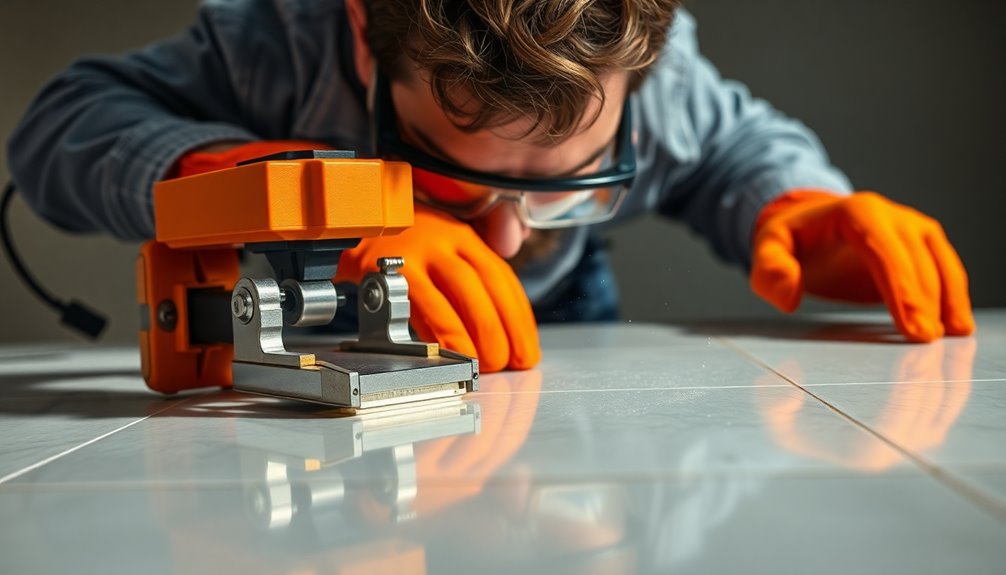
Cutting porcelain tile can be rewarding, but it's crucial to prioritize safety throughout the process.
Always wear safety goggles to protect your eyes from flying debris; sharp fragments can cause serious injuries. To prevent respiratory issues, use a dust mask or respirator to minimize inhalation of harmful silica dust released during cutting.
Verify your workspace is well-ventilated to help dissipate dust and maintain air quality. Keep your hands clear of the cutting area to avoid injuries; rely on appropriate tools for handling tiles instead.
Finally, follow the manufacturer's instructions for all tools, including safety guidelines and recommended personal protective equipment (PPE), to guarantee safe operation.
Frequently Asked Questions
How to Make Intricate Cuts on Porcelain Tile?
To make intricate cuts on porcelain tile, start by marking your desired lines with a grease pencil.
Using a diamond band saw blade is great for flexibility and precision. For straight cuts, score the tile with a manual cutter and follow up with tile nippers for curves.
A wet saw with a diamond blade can help you achieve smooth cuts while minimizing dust.
Practice on scrap pieces to perfect your technique before working on your final tiles.
What Is the Best Method to Cut Porcelain Tile?
When you're looking to cut porcelain tile, using a wet saw is your best bet.
It'll give you clean, precise cuts while keeping dust and heat to a minimum.
If you need straight cuts on thinner tiles, a manual tile cutter can work, but you'll need some skill to avoid chipping.
For intricate designs, an angle grinder with a diamond blade is useful, though it can be messier and rougher at the edges.
What Is the Best Tool to Cut Porcelain Tile With?
When you're looking to cut porcelain tile, the best tool you can use is a wet saw. It guarantees clean, precise cuts by using water to manage dust and heat.
If your project is smaller, a manual tile cutter could be a great cost-effective option.
For intricate designs, consider an angle grinder with a diamond blade, but keep in mind it might leave rough edges.
Always choose the right tool for your specific needs!
How to Prevent Chipping When Cutting Porcelain Tile?
When you're cutting porcelain tile, it's crucial to dance delicately with the blade to prevent chipping.
First, use a high-quality diamond blade designed for porcelain. Score the tile gently, applying consistent pressure before snapping it.
Adding masking tape along the cut line stabilizes the surface. If you have intricate cuts, a tile nipper can help carefully break away small sections.
Using a wet saw cools the tile and blade, reducing heat-related chips.
Conclusion
Cutting porcelain tile doesn't have to feel like a challenging puzzle. Just like a sculptor chiseling away at marble, you can achieve a flawless finish with the right tools and techniques. By mastering the methods we've discussed, you'll transform your project from ordinary to extraordinary. Remember to practice your skills and keep safety in mind. With patience and precision, you'll make clean cuts that enhance your space beautifully!
